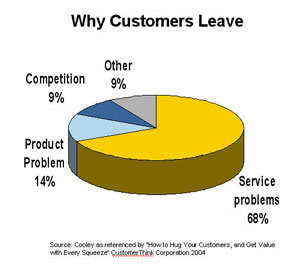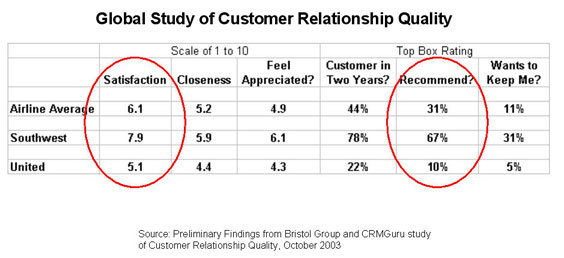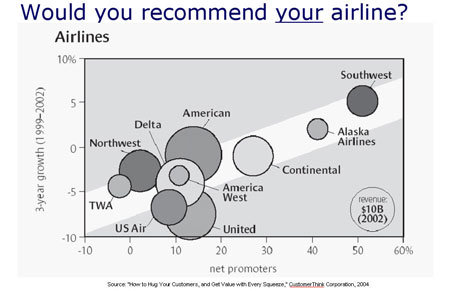Summary
Customer Relationship Management (CRM) reflects a business strategy that aims at managing customers for long-term values. CRM depends on customer-based approaches and culture, which support result-oriented marketing, sales, and services to customers.
Thus, CRM applications or software can enhance effective management of customer relationships. This article focuses on how the airline industry can apply CRM in its operation management for creating value to customers and the organisation (CRM Trends, 2012).
The US airline industry operates in a competitive and expensive environment. As a result, there is a need to focus on customers’ relationships, means of generating revenues, and cost-cutting methods. Focus on customer management shall ensure profitability and competitive strategy for airlines.
In this case, CRM application can aid the airline industry manage its customers. However, the industry has failed to use CRM holistically in its operation. Thus, the industry cannot derive significant values from it. Consequently, the airline industry must change its strategy in order to derive values from CRM strategy.
First, the industry must segment its customers based on needs and value so as to understand needs of customers.
Second, the industry requires CRM initiative, which focuses on needs of customers to create values.
Third, the industry must change its design and management strategy so as to focus on customers and define roles of staff in using CRM strategy. This should reflect customer-based approaches to management so that the industry can get and retain high net worth clients.
The CRM tool should be able to perform customer analytics for decision-making purposes. This information can aid the industry improve both customer services and operational management for efficiency and derive long-term values from effective relationship management.
The airline industry situation
In the recent past, the airline industry has faced challenges related to recessions, effects of terrorisms, unionised workers slowdown, and volcanic ash cloud. These factors have resulted into decline in profitability, flight frequencies, and increase in costs of insurance and labour among others.
The global airline industry is under threat of making losses. The industry profitability has become unpredictable, but in most cases, it suffers operational losses. In addition, stiff competition from budget airlines has affected full-service airlines.
In fact, budget airlines Southwest Airlines did not experience many challenges of 2008 recession due to their operational models. As a result, market shares of low cost airlines are increasing as full-service airlines grapple with declining market shares. Budget airlines have gained popularity due to their low cost strategy.
However, they do not have competitive customer services. This implies that full-service airlines can capitalise on their customer services for efficiency and profitability.
Thus, their airline must realise that cost-cutting coupled with effective customer relationship management shall create competitive advantage in the industry for long-term values.
These challenges have forced the airline industry to seek for values from CRM applications. This implies that the industry has recognised the need to enhance customer services for competitive advantage.
CRM should ensure customers’ loyalty and maximise revenues in the industry, lower costs, and increase operational efficiencies. Full-service airlines have applied CRM tools as a wider part of the business strategy.
On the other hand, budget airlines do not have keen interests on CRM applications for improving their customer services.
The airline industry has realised that CRM can provide long-term values to the industry. However, most airline companies do not utilise their CRM applications optimally.
Airlines should rely on analytical tools of CRM for decision-making. CRM can provide valuable information the industry can use to segment its customers. Airlines have deployed CRM tools to match their competitors. In this sense, they fail to utilise it optimally for competitive advantage and differentiation.
The industry has also failed to execute its CRM strategy effectively. In most cases, the CRM applications do not reflect companies’ visions or set directions. In addition, various departments also have their diverse goals in relation to organisational objectives and strategies.
For instance, the financial department’s goals focus on driving revenues and may lack customer service initiatives whereas other departments may not have CRM tools at every point to serve customers efficiently.
This implies that CRM strategy may not achieve its intended objectives. Thus, the airline industry must align its business strategy and IT strategy in order to create value for all stakeholders.

The industry insight
In most cases, competitors prefer to learn from mistakes of first initiators. These may be to reduce costs or avoid risks. For instance, Delta waited for other operators to deploy check-in kiosks technology. The company claimed that it would save costs and increase accessibility.
This turned out to be true according to Forrester Research of 2005 (Forrester Research, 2005). The company system resulted into increased customers’ usages due to signage and easy access. The company differentiated its kiosks from others in the area to create value for customers.
This shows that most airline companies do not resort to establish differentiation strategy in deploying their IT strategies. Thus, majorities of airline companies fail to introduce CRM applications that can result into sustainable differentiation.
Airline companies do not deploy their CRM tools for differentiation, but rather to march competitions. These trends have created poor results for customers and companies. As these customer-oriented initiatives become commonplace, they lose their values to customers.
This implies that imitation is a common trend in the airline industry. The main aim of CRM is to distinguish a firm from its competitors by providing personalised services to customers (Bradshaw and Brash, 2001). However, the practice at the airline industry makes CRM uniform for all customers.
Airline companies can effectively utilise CRM to improve relationships with their customers. This is a step towards differentiation and avoidance of identical services.
Effective differentiation requires airline firms to understand how clients react to change strategies and carefully analyse their return on investment (ROI) based on services provided to customers. This is the only way for airline firms to realise RIO and effectiveness of their CRM strategies.
Reactions to competitors’ strategies may not be adequate. Airlines need to rely on CRM insights based on customers’ behaviours in order to enhance values for customers.
This shall ensure that the industry drives maximum value from CRM applications. The industry should base CRM strategies on needs of customers, rather than strategies of competitors (Binggeli et al, 2002).
Airline companies should also understand the importance of market segmentation when deploying CRM strategy. This should entail understanding customers’ needs and value. Segmentation acts as a key to effective utilisation of CRM platforms. There are many ways of segmenting customers.
However, a value-based classification can enable the industry to comprehend the value of various customer segments. Need and value assessments enable the company to understand net worth of its customers and their contributions to the company’s profitability.
This insight is useful in making marketing decisions and adjusting CRM strategies to meet customers’ needs.
Most airline firms use demographic characteristics and frequency programs to segment customers. These methods may not provide all the information the industry needs to make effective decisions. The airline industry should rely on information from business and leisure travels customers for decision-making. This should aim at improving a firm’s profitability. In addition, the industry can also rely on frequent flyer information using miles for segmentation. However, this may yield different results based on passenger class and discounts among others.
It is necessary for the US airline industry to understand its customers’ value. CRM can enable the industry to determine high net worth customers. For instance, the United Airlines has a system that enables it to identify high value customers. Consequently, the company can proactively provide alternative transport to this segment in cases of flight cancellations. This is a differentiation strategy.
The US airline industry should apply a value-based approach in customers’ segmentation. This strategy enables the industry to value customers based on their influence and power to the business. The industry can use net worth of customers and frequencies of travel to segment customers. The monetary value enables a firm to understand spending habits of a client. This information can provide the airline industry with information necessary in making investment decisions in a specific segment.
Customers’ needs also vary. For instance, a family would need extra space for luggage at lower costs whereas a business executive may require a nonstop flight for efficiency. Better understanding of customers should enable the airline industry adjust their value propositions to various segment of the market based on pricing, customer service, routes, and destinations among others.

Implications
The US airline industry should differentiate its services based on customers and their needs. This implies that the industry must understand factors, which drive profitability and result into customers’ satisfaction. The airline industry must seek for customers’ feedback on services provided.
Using customer analytics in CRM applications, the industry can develop different segments of customers. Therefore, effective utilisation of CRM applications can provide value to airline companies (Korper and Ellis, 2001).
Self-services like kiosks are crucial in cost-cutting. They help the industry to increase accessibility and reduce costs. Low costs can make the industry provide affordable services to customers. CRM can be useful in this approach as it can allow customers to purchase air tickets and check-in online.
This provides convenience to customers at affordable costs. In this context, the industry must encourage its customers to embrace the use of technology-based self-services. Self-service can also enhance customers’ levels of satisfaction. The industry should base any self-service initiative from customers’ perspective.
The key to success of such services depends on providing information for quick decision-making to enhance travelling experiences (Kalakota and Robinson, 2001). High net worth passengers need extra services from the airline industry. Such passengers have received incentives based on frequencies of their travels.
The US airline industry has extended to Internet and e-mail access. For instance, Southwest Airlines firm provides WiFi Internet access to its customer to enable them be “productive and stay entertained while flying with full access to the Internet, including e-mail, shopping, and virtual private networks (VPN) together with unlimited access to channels through live TV” (Southwest Airlines, 2012).
However, these services are available at an extra cost of $5 throughout the day and in hotspot flights. This trend began in 2003 and full-service flights worldwide soon embarked on testing their fleets for Internet connection. This explains why the industry depends on competitors’ strategies (Armstrong, 2003).
The service cost $32 in British Airways and available to premium and business economy classes. This is price differentiation strategy among airline companies.
Ancillary services, which most budget flights offer enhance shareholders value. This may include extra charges for luggage. However, these services may be unpopular among customers.
Customers may need cheap services. However, the important factor is to determine what drives shareholders’ value. Still, the industry must strive to build customer loyalty for long-term values.
Passengers can only realise value from improved efficiency, and the industry can only achieve value from customer by using CRM. CRM can help the airline industry in scheduling routes.
This can enable the industry to identify routes, which result into loses and formulate new strategies for such routes. CRM can also help airline companies identify competitive routes for differentiation purposes.
CRM also acts as a predictive tool and informs the industry decisions on expansion strategies based on frequencies of travels.
CRM can help the industry determine prices and factors passengers consider when making their purchase decisions. This approach can enable the industry determine yield from passengers. Analytic systems in CRM help the industry determine appropriate costs and areas where it can save costs. The idea is to enhance customer relationship through attractive pricing.

Challenges with CRM
Airline companies have not effectively defined CRM leadership. Most of these firms do not task any staff with the responsibility of ensuring effective utilisation of CRM in relation to organisational strategy. Leadership for CRM must come from executives of the company for effective implementation.
Executives also fail to understand CRM strategy. Most of these executives limit their understanding to obvious procedures. However, they rarely understand other capabilities, which the system can achieve. The airline industry should define clear vision for CRM based on needs of customers. This implies that a company must identify all challenges its customers experience and align them with CRM.
Most companies fail to approach CRM applications from multiple perspectives. In most cases, they leave such applications to customer service department. However, many departments should be responsible for effective utilisation of CRM based on the overall goals and IT strategy of a firm.
This process needs effective communication among various departments to avoid cases of disconnect and poor results. The IT department must lead this process based on reports from other departments responsible for CRM implementation.
This enhances effective implementation and integration of the CRM application into organisational practices (Imhoff et al, 2001).
The company must also train its employees so that they can effectively use CRM. This process also needs incentives to enable staff adopt the use of CRM for high-level services.
The airline industry must also adopt customer service attitude, and it must cover both internal and external customers. This is the approach of Southwest Airlines.
The company should encourage feedback from employees on service issues. This can provide better opportunities for a firm to understand its customers. Consequently, a firm can adjust its services to meet unique needs of different customers it serves (IBM, 2008).
The way forward
From challenges of the US airline industry, customer management has become a critical tool for success. Application of CRM tools requires realistic approaches based on customers’ needs and expectations from the company.
This allows the firm and its customers to realise the value of CRM. In short, a clear strategy for the US airline industry CRM application should depend on the following aspects.
First, these companies should have visions for their CRM strategies. This helps the organisation to understand how CRM can change its relationship with customers. It should also reflect values such as savings, low operating costs, and potential increase in revenue the company can derive from the CRM application.
The process requires effective communication of such values to employees so that they can understand overall importance of the system.
Second, airline companies should focus on enhancing customer values. This is necessary to understand profitability of every customer.
Customer value helps a company to identify service levels for different segments of the “market, identify existing opportunities, create loyalty, and recruit new customers” (IBM, 2008). Value-based differentiation can be effective in aligning CRM strategy with the focus on deriving value from customers.
Third, airline companies must train their employees on effective use of CRM tools. This should also include the importance of customer service to the company.
Provisions of information can help in facilitating the process of improving effective customer service. Airline companies must also introduce attractive incentives to their loyal customers. Such approaches can include discounts or free flights at a given period.
Fourth, the best way to determine effectiveness of CRM should involve the use of performance metrics. This can ensure that the organisation and its customers get value from CRM applications.
Targets should be realistic so that the company can accurately review them on a need basis. The use of regular feedback should drive CRM initiatives in a company.
Finally, customer service is a lifelong process. This implies that airline companies must also seek for new information in order to improve their levels of services to customers (IBM, 2008).
Conclusion
CRM can work effectively in the airline industry if companies can adopt and integrate it with overall objectives of the organisation. It can define differentiation and improve revenue for the company.
Most budget airlines suffer from poor customer service. CRM provides opportunities for them to improve their experiences with customers.
Executives must spearhead roll outs of CRM in a holistic way to enable other employees support the implementation process. It is only through effective provisions of tools, knowledge, training, and customer focused team that an organisation can realise the true value of CRM application.
CRM can give a company a complete view of its customers. This view enables the US airline companies to enhance “the quality and satisfaction of all customers and increase profitability” (CRM Trends, 2012). CRM should promote a win-win situation for the organisation and customers.
The CRMGuru study showed that Southwest Airlines had effectively used its CRM tools in managing customers for creating value to customers. As a result, the company has achieved repeat business and high rates of recommendations from its customers.
Reference List
Armstrong, D 2003, ‘Airlines testing in-flight passenger Internet access’, Chronicle, vol.3, pp. 1-2.
Binggeli, U, Pommes, C, Granville, G and Gupta, S 2002, Flying High with airline CRM, McKinsey & Company, New York.
Bradshaw, D and Brash, C 2001, ‘Surviving in the e-Business world: How to personalise customer relationships for increased profitability’, International Journal of Retail & Distribution Management, vol. 29, no. 12, pp. 520 – 530.
CRM Trends 2012, CRM Best Practices. Web.
Forrester Research 2005, Best and Worst of Kiosk Environments, 2005: Delta’s self-service kiosk technology earns high marks. Web.
IBM 2008, ‘Customer Focused Airline: A Vision for Airline CRM’, IBM Travel and Transportation, vol. 5, pp. 1-3.
Imhoff, C, Loftis, L, Geiger, G and Inmon, W 2001, Building the Customer-Centric Enterprise Data Warehousing Techniques for Supporting Customer Relationship Management, Wiley Computer Publishing, New York.
Kalakota, R and Robinson, M 2001, e-Business 2.0 Roadmap for Success, Addison-Wesley, Boston.
Korper, S and Ellis, J 2001, E-Commerce Book Building the E-Empire, Academic Press, San Diego.
Southwest Airlines. (2012). WiFi Internet Access-Now Available. Web.